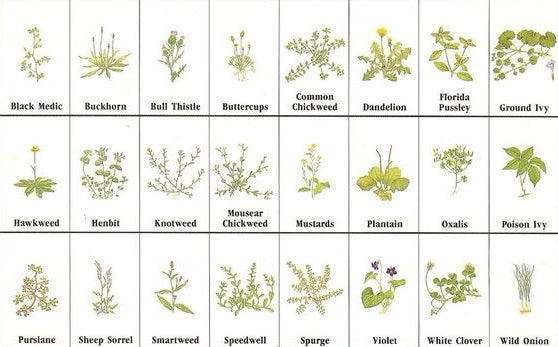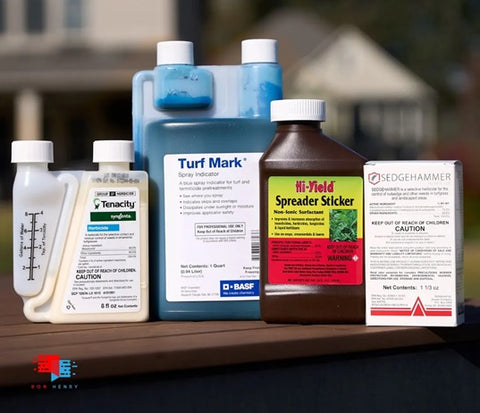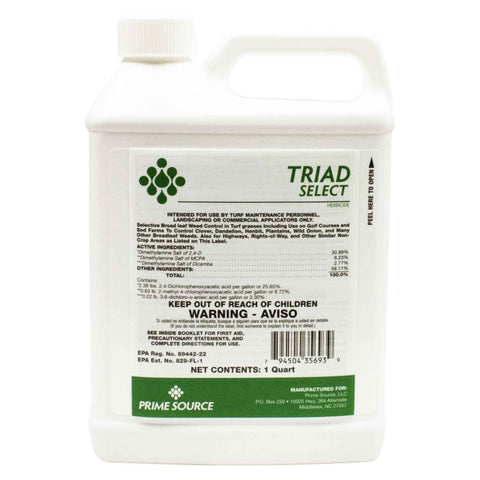The Best Broadleaf Weed Killers for Your Lawn
Unlike the uniform blades of grass that make up your lawn, broadleaf weeds stand out with their distinctive, often broader, and flat leaves. These unwelcome interlopers not only disrupt the visual harmony of your lawn but can also compete with grass for nutrients, water, and sunlight. As a result, addressing broadleaf weeds becomes crucial for preserving the health and vibrancy of your lawn.
In this guide, we delve into the world of broadleaf weedkillers, exploring the most effective solutions to reclaim your lawn's glory.
Common Types of Broadleaf Weeds

- Dandelions: Recognizable by their yellow flowers and distinctive fluffy seed heads, dandelions are a prevalent broadleaf weed found in lawns across various regions.
- Clover: Characterized by its trifoliate leaves and small white or pink flowers, clover is both a common weed and a nitrogen-fixing plant that can invade lawns.
- Chickweed: Low-growing with small white flowers, chickweed is known for spreading rapidly and forming dense mats if left unchecked.
- Ground ivy (Creeping Charlie): Ground ivy is a low-growing weed with scalloped leaves and small, tubular purple flowers. It can be aggressive and challenging to control.
- Wild violet: Wild violets have heart-shaped leaves and produce small purple flowers. They are resilient and can be challenging to eliminate due to their rhizomatous growth.
- Broadleaf Plantain: With broad, oval-shaped leaves, plantain is often found in compacted soil. It's resistant to frequent mowing and can be a persistent lawn invader.
- Buckhorn plantain: This weed has lance-shaped leaves and is found in high-traffic areas. Buckhorn plantain is known for its long, slender seed heads.
- Thistle: Thistles are spiky plants with distinctive prickly leaves and colorful flower heads. They can be invasive and difficult to eradicate.
- Common ragweed: A major contributor to seasonal allergies, common ragweed has deeply lobed leaves and produces inconspicuous green flowers.
Characteristics of Broadleaf Weeds

Broadleaf weeds can be identified by their non-grassy appearance, which often includes:
- Broad leaves: Unlike the narrow blades of grass, broadleaf weeds have leaves with a more expansive and varied shape.
- Divergent growth: These weeds often grow in a manner that contrasts with the uniform, upright growth pattern of grass.
- Distinctive flowers: Many broadleaf weeds produce noticeable flowers, contributing to their easy identification.
Potential Harm Caused by Broadleaf Weeds
While broadleaf weeds might seem like mere nuisances, their presence poses various threats to your lawn's health:
- Competition for resources: Broadleaf weeds compete with grass for sunlight, water, and essential nutrients, potentially stunting the growth of your lawn.
- Aesthetic degradation: The visual appeal of your lawn can be compromised, affecting the overall curb appeal of your property.
- Weed spread: Left unchecked, broadleaf weeds can spread rapidly, creating an extensive network that can be challenging to control.
Factors to Consider When Choosing a Broadleaf Weedkiller
Lawn Type and Grass Compatibility
- Grass varieties: Different weedkillers may interact differently with various grass species. Consider the type of grass in your lawn to ensure compatibility and prevent unintended damage.
- Warm-season vs. cool-season grass: Understanding your lawn's predominant grass type — whether it's warm-season (e.g., Bermuda, Zoysia) or cool-season (e.g., Kentucky bluegrass, Fescue) — will influence the choice of weedkiller.
Weed Severity and Coverage
- Weed infestation level: Assess the extent of broadleaf weed infestation in your lawn. Selective herbicides application targeting specific weeds may suffice for minor issues, while widespread problems might require a broadcast application to treat the entire lawn.
- Coverage area: Determine the size of the area needing treatment. Some weedkillers are formulated for smaller patches, while others are designed for larger lawns.
Environmental Considerations
- Pet and child safety: If you have pets or children frequently playing on the lawn, opt for weedkillers with quick drying times to minimize potential exposure.
- Environmental impact: Consider eco-friendly options or herbicides with minimal ecological impact, especially if your lawn is near gardens, water bodies, or natural habitats.
Application Method and Ease of Use
- Spray vs. granular: Weedkillers come in various application forms, including sprays and granules. Choose based on personal preference, the size of the area, and ease of application.
- User-friendly formulas: Look for products with clear instructions, user-friendly formulations, and easy application processes to ensure effective and hassle-free use.
Residual Effects and Impact on Nearby Plants
- Residual activity: Some weedkillers have longer residual effects, preventing weed regrowth for an extended period. Consider this factor based on your lawn's specific needs.
- Non-target plant damage: Be cautious of potential harm to nearby plants. Selective herbicides target specific weeds without affecting desirable plants, while non-selective herbicides may harm a broader range of vegetation.
Considering these factors will guide you toward choosing the most suitable broadleaf weedkiller for your lawn, ensuring effective and targeted weed control without compromising the health of your grass or the surrounding environment.
Related: The Best Four Products for Killing Weeds Without Killing Grass
Top Broadleaf Weedkillers on the Market
Here are some of the best broadleaf weedkillers on the market for controlling broadleaf weeds, and many of them eliminate grassy weeds, sedges, and undesired Poa annua, too.
1. Celsius and Certainty Herbicide Kit — Ultimate Weed Control for Warm-Season Grass
This powerhouse duo blends two potent weed killers to create a formidable solution. With this herbicidal combination in the Celsius and Certainty Herbicide Kit, you can eradicate weeds effectively while safeguarding the health of your grass.
Key Features:
- Suitable for all warm season lawns, excluding Bahiagrass: Ideal for Bermuda, Zoysia, and St. Augustine lawns.
- Targets over 180 grassy and broadleaf weeds.
- It can be applied over a broad temperature range.
- Celsius and Certainty work together for a potent herbicidal effect.
- Saves money compared to purchasing individual herbicide products.
- Kit includes Celsius WG Herbicide, Certainty Herbicide, Hi-Yield Surfactant, and Blue Marker Dye.
Application Tips:
- Apply using a battery-powered 4-gallon sprayer with a TeeJet foliar spray tip.
- Not suitable for application via hose-end sprayers.
- Avoid application if temperatures exceed 100°F. Apply in the evening when temperatures dip below 100°F.
- Spot spray is recommended during high temperatures.
- Use a non-ionic surfactant with the kit for better results.
- Do not transfer clippings to non-target areas post-treatment.
- Wait at least two days before and after application before resuming mowing for optimal results.
2. Recognition and Fusilade II Kit — For Targeting Grassy, Sedge, and Broadleaf Weeds
In the battle against Bermudagrass encroaching on your Zoysia and St. Augustine lawn, the Recognition and Fusilade II Herbicide Kit emerges as the ultimate solution. This comprehensive kit integrates two potent weed killers, creating a robust combination that effectively and safely eliminates grassy, sedge, and broadleaf weeds from your lawn.
Key Features:
- Controls over 85 grassy, sedge, and broadleaf weeds.
- Safe to use on Zoysia grass, St. Augustine grass, and Kikuyu grass.
- Specifically formulated to safely remove common and hybrid Bermuda from Zoysia and St. Augustine lawns.
- Recognized as a temperature-safe combination suitable for a variety of grass types.
- It can be applied over a broad temperature range.
- Kit includes Recognition Herbicide, Fusilade II Herbicide, Hi-Yield Surfactant, and Blue Marker Dye.
Application Tips:
- Apply using a battery-powered 4-gallon sprayer with a TeeJet foliar spray tip.
- Not suitable for application via a hose-end sprayer.
- Avoid application if temperatures exceed 95°F or when winds exceed 10 mph.
- Recognition MUST be combined with Fusilade II for use on St. Augustine and kikuyu grass; it CANNOT be used alone.
- Wait four to six weeks between applications.
- Do not exceed three applications per calendar year.
- Use a non-ionic surfactant with Recognition for better results.
- For best results, avoid mowing seven days before and seven days after application.
- Do not transfer cuttings to non-target areas post-treatment.
3. Tenacity and SedgeHammer Kit — Superior Weed Control for Cool Season Grass
Fed up with weeds wreaking havoc on your cold-season lawn? Your solution lies in the Tenacity and SedgeHammer Herbicide Kit! This comprehensive kit brings together two potent weed killers, ensuring the eradication of weeds without compromising the health of your grass. Furthermore, it is designed for safe application across a wide temperature range. Look no more for an effective and temperature-flexible solution for your lawn.
Key Features:
- Effectively kills over 50 grassy and broadleaf weeds without harming the grass.
- Controls sedges, including nutsedge, kyllinga, annual, and globe.
- Targets common weeds such as dandelions, dollar weed, ground ivy, and more.
- Safe to apply over a broad temperature range, ensuring versatility in application.
- Kit includes Tenacity Herbicide, SedgeHammer Herbicide, Hi-Yield Surfactant, and Blue Marker Dye.
- Tenacity is safe for Kentucky bluegrass, Centipede grass, Buffalo grass, Tall Fescue, Perennial Ryegrass, Fine Fescue, and St. Augustine (sod farms only).
- SedgeHammer is safe for cool and warm-season grasses.
Application Tips:
- Apply using a battery-powered 4-gallon sprayer with a TeeJet foliar spray tip.
- Not suitable for application via a hose-end sprayer.
- Avoid application if temperatures exceed 100°F. Evening application is recommended if temperatures are high.
- Spot spray is recommended in extreme heat instead of blanket spraying.
- For best results, do not mow two days before and two days after application. For example, if you plan to spray Tenacity and SedgeHammer on Saturday, your last mow would be Thursday. You would resume mowing on the following Tuesday.
4. Triad Select™ Herbicide — Advanced Broadleaf Weed Control
Triad Select™ Herbicide employs a unique blend of three potent herbicides to effectively eliminate a diverse array of broadleaf weeds. Notably, this herbicidal formula stands out for its grass-friendly properties and is particularly renowned for its efficacy in combatting troublesome dandelions. Positioned as an exceptional herbicidal solution, Triad Select surpasses typical store-bought options, offering users a significant upgrade in weed control.
Key Features:
- Ideal for warm and cool-season lawns. Do not use on Centipede or St Augustine grasses.
- Specifically formulated not to harm grass when used as directed.
- The active ingredients are 2,4-D (30.89%), MCPA (8.23%), and Dicamba (2.77%).
- Targets dandelion, clover, chickweed, wild onion, broadleaf plantain, and more.
- A potent herbicide that provides professional-grade results.
Application Tips:
- Use a battery-powered 4-gallon sprayer with a TeeJet foliar spray tip for optimal coverage.
- Not suitable for application via a hose-end sprayer.
- Avoid application if temperatures exceed 90°F. Evening application is recommended if temperatures are high.
- Spot spray is recommended during extreme heat instead of blanket spraying.
- Wait at least two days before and after application before resuming mowing for optimal results.
5. Specticle FLO Pre-Emergent Herbicide — Unmatched Warm-Season Weed Control

For maintaining the lush beauty of your warm-season turf, Specticle FLO stands out as the ultimate choice. Demonstrating its efficacy in delivering unparalleled preemergence control, Specticle FLO has proven itself against even the most stubborn weeds.
Key Features:
- Offers long-lasting, broad-spectrum control against over 60 broadleaf weeds and grassy species.
- Effective against challenging weeds like dodder, henbit, kochia, and more.
- Liquid formulation ensures rapid soil penetration, staying ahead of weed emergence.
- Convenient application using a backpack or handheld sprayer.
- Requires rainfall or irrigation before weed germination to activate herbicide effectively.
- Extended residual control against the notoriously persistent Poa annua.
- Safe for warm-season lawns like Bermuda, St. Augustine, Zoysia, Centipede, Bahia, and Buffalograss. Not suitable for application on cool-season grasses.
- Specticle FLO utilizes the active ingredient indaziflam to provide extended control, making it a comprehensive solution for maintaining the health and beauty of warm-season lawns.
Application Tips:
- Use a battery-powered 4-gallon sprayer with a large droplet nozzle for optimal coverage.
- The ideal application time is late summer to early fall for maximum effectiveness.
These top broadleaf weedkillers offer a range of options to address various lawn care needs. Choosing the right product depends on factors such as the size of your lawn, the severity of weed infestation, and your preference for organic or synthetic solutions. In the following sections, we'll provide valuable tips for applying these weedkillers effectively and explore eco-friendly alternatives for conscientious lawn care.
Related: What Are Pre-Emergent Herbicides and When You Should Apply Them
Application Tips and Tricks
Best Practices for Applying Broadleaf Weedkillers
- Timing is key: Apply weedkillers when weeds are actively growing for optimal absorption. Early spring and fall are often ideal periods, avoiding extreme temperatures.
- Weather conditions: Choose a calm, dry day for application to prevent drift and ensure the product adheres to the weeds. Avoid rainy or windy days that can reduce effectiveness.
- Uniform coverage: Ensure even distribution of the weedkiller across the entire lawn or targeted area. Pay attention to areas with dense weed populations.
Timing Considerations for Optimal Results
- Early intervention: Address weed issues as soon as they appear to prevent them from establishing deep roots and spreading extensively.
- Repeat applications: For stubborn or persistent weeds, consider follow-up applications as recommended on the product label. This is crucial for complete eradication.
Related: How to Kill Weeds in Flower and Mulch Beds
Dos and Don'ts to Ensure Effective Weed Control
- Do follow instructions: Read the manufacturer's instructions carefully to maximize effectiveness and minimize the risk of unintended consequences.
- Do use protective gear: Wear appropriate protective gear, such as gloves and eyewear, during application to prevent skin or eye irritation.
- Don't overapply: Avoid applying excessive amounts of weedkiller, as this may harm your grass and increase the risk of environmental impact.
- Don't mow immediately: Refrain from mowing your lawn immediately before or after applying weedkiller. Allow time for the product to be absorbed.
By adhering to these application tips and timing considerations, you'll enhance the effectiveness of your chosen broadleaf weedkiller, leading to a healthier, more vibrant lawn.
Lawn Maintenance Tips for Long-Term Weed Control
Regular Mowing and Proper Watering
- Mowing height: Maintain the recommended mowing height for your grass type. Taller grass shades the soil, reducing weed germination and promoting a healthier lawn.
- Consistent watering: Water your lawn deeply and infrequently to encourage deep root growth in grass. Shallow and frequent watering can promote weed growth.
Fertilization Practices to Promote a Healthy Lawn
- Balanced fertilization: Apply a balanced fertilizer according to your lawn's needs. If you don’t know your lawn needs, do a soil test. Well-nourished grass is better equipped to compete with weeds for resources.
- Seasonal considerations: Adjust your fertilization and lawn care schedule based on the seasons, providing nutrients when the grass is actively growing and needs the most support.
Monitoring and Early Intervention for Weed Prevention
- Regular inspections: Routinely inspect your lawn for early signs of weed growth. Addressing weeds in their early stages prevents them from establishing and spreading.
- Spot treatment: For minor weed issues, consider spot-treating with targeted solutions to avoid unnecessary application of broad-spectrum weedkillers.
By incorporating these maintenance practices into your lawn care routine, you create a proactive approach to weed control, reducing the likelihood of invasive broadleaf weeds taking hold in the first place.
Watch: Get Rid of Weeds This Spring
By taking these steps, you're not only investing in the health and beauty of your lawn but also contributing to the overall well-being of your outdoor space. Here's to a vibrant, weed-free future for your lawn!
Enroll on our Golf Course Lawn Academy course for a more comprehensive breakdown of your yearly lawn care schedule with specialist advice.




